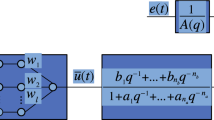Abstract
This paper investigates the use of particle swarm optimization (PSO) in the identification of Hammerstein models with known nonlinearity structure. The parameters of the Hammerstein model are estimated using PSO from the input–output data by minimizing the error between the true model output and the identified model output. Using PSO, Hammerstein models with known nonlinearity structure and unknown parameters can be identified. Moreover, systems with non-minimum phase characteristics can be identified. Extensive simulations have been used to study the convergence properties of the proposed scheme. Simulation examples are included to demonstrate the effectiveness and robustness of the proposed identification scheme.

Similar content being viewed by others
References
Haddad A.H., Thomas J.B.: On optimal and suboptimal nonlinear filters for discrete inputs. IEEE Trans. Inform. Theory IT-14(1), 16–21 (1968)
Deboer E.: Cross-correlation function of a bandbass nonlinear network. Proc. IEEE. 64(9), 1443–1446 (1976)
Miller J.H., Thomas J.B.: Detectors for discrete time signals in non-Gaussian noise. IEEE Trans. Inform. Theory IT-18(3), 241–250 (1972)
McCannon T.E., Gallagher N.C., Minoo-Hamedani D., Wise G.L.: On the design of nonlinear discrete time predictors. IEEE Trans. Inform. Theory. IT-28(3), 366–371 (1982)
Maqusi M.: Performance of baseband digital transmission in nonlinear channel with memory. IEEE Trans. Commun. 33(7), 715–718 (1985)
Kung M.C., Womack B.F.: Discrete time adaptive control of linear dynamical systems with a two-segment peicewise-linear asymmetric nonlinearity. IEEE Trans. Automat. Contr. AC-29(2), 170–173 (1984)
Stapleton J.C., Bass S.C.: Adaptive noise cancellation for a class of nonlinear systems. IEEE Trans. Circuit Syst. CAS-32(2), 143–150 (1985)
Eskinat E., Johnson S.H., Luyben W.L.: Use of Hammerstein models in identification of nonlinear systems. Am. Inst. Chem. Eng. J. 37, 255–268 (1991)
Hunter I.W., Korenberg M.J.: The identification of nonlinear biological systems: Wiener and Hammerstein cascade models. Biol. Cybern. 55, 135–144 (1986)
Hassouna, S.; Coirault, P.; Ouvrard, R.: Continuous nonlinear system identification using series expansion. American Control Conference, Arlington (2001)
Kozek, M.; Jovanovic, N.: Identification of Hammerstein/Wiener nonlinear systems with extended Kalman filters. American Control Conference, Arlington (2002)
Voros J.: Recursive identification of Hammerstein systems with discontinuous nonlinearities. IEEE Trans. Automat. Contr. 48(12), 2203–2206 (2003)
Chen H.: Pathwise convergence of recursive identification algorithms for Hammerstein systems. IEEE Trans. Automat. Contr. 49(10), 1641–1649 (2004)
Jia, L.; Chiu, M.; Ge, S.: Neuro-fuzzy system based identification for Hammerstein processes. 5th Asian Control Conference, pp. 104–111 (2004)
Janczak A.: Identification of nonlinear systems using neural networks and polynomial models. Springer, Berlin (2005)
Goethals I., Pelckmans K., Suykens J., Moor B.D.: Subspace identification of Hammerstein systems using least squares support vector machines. IEEE Trans. Automat. Contr. 50(10), 1509–1519 (2005)
Zhao W., Chen H.: Recursive identification for Hammerstein systems with ARX subsystem. IEEE Trans. Automat. Contr. 51(12), 1966–1974 (2006)
Hong X., Mitchell R.J.: Hammerstein model identification algorithm using Bezier–Bernstein approximation. Control Theory Appl. 1(4), 1149–1159 (2007)
Al-Duwaish H., Karim M.N., Chandrasekar V.: Hammerstein model identification by multilayer feedforward neural networks. Int. J. Syst. Sci. 28(1), 49–54 (1997)
Al-Duwaish H., Karim M.N.: A new method for the identification of Hammerstein model. Automatica 33(10), 1871–1875 (1997)
Narenda, K.S.; Gallman, P.G.: An iterative method for the identification of nonlinear systgems using the Hammerstein model. IEEE Trans. Automat. Contr. AC-11(7), 546–550 (1966)
Chang, F.H.I.; Luus, R.: A noniterative method for identification using Hammerstein model. IEEE Trans. Automat. Contr. AC-16(10), 464–468 (1971)
Gallman P.G.: An iterative method for the identification of nonlinear systems using Uryson model. IEEE Trans. Automat. Contr. AC-20(12), 771–775 (1975)
Greblicki W., Pawlak M.: Nonparametric identification of Hammmerstein systems. IEEE Trans. Inf. Theory IT-35(3), 409–418 (1989)
Fogel, L.J.: Evolutionary programming in perspective: the topdown view. In: Robinson (eds.) Computational intelligence: imitating life. IEEE Press, Piscataway, NJ (1994)
Goldberg, D.E.: Genetic algorithms in search optimization, and machine learning, Addison-Welsey, Reading MA (1989)
Rechenberg, I.: Evolution strategy. In: Robinson (eds.) Computational intelligence: imitating life. IEEE Press, Piscataway, NJ (1994)
Shi, Y.H.; Eberhart, R.C.; Chen, Y.B.: Design of evolutionary fuzzy expert system. In: Proceedings of 1997 Artificial Neural Networks in Engineering Conference, St. Louis, USA (1997)
Ljung, L.; Soderstrom, T.: Theory and practice of recursive identification. MIT Press, Massachusetts (1983)
Leontaritis I., Billings S.: Experimental design and identifiability for nonlinear systems. Int. J. Syst. Sci. 18(1), 189–202 (1987)
Al-Duwaish H.: A genetic approach to the identification of linear dynamical systems with static nonlinearities. Int. J. Syst. Sci. 31(3), 307–314 (2000)
Author information
Authors and Affiliations
Corresponding author
Rights and permissions
About this article
Cite this article
Al-Duwaish, H.N. Identification of Hammerstein Models with Known Nonlinearity Structure Using Particle Swarm Optimization. Arab J Sci Eng 36, 1269–1276 (2011). https://doi.org/10.1007/s13369-011-0120-2
Received:
Accepted:
Published:
Issue Date:
DOI: https://doi.org/10.1007/s13369-011-0120-2




